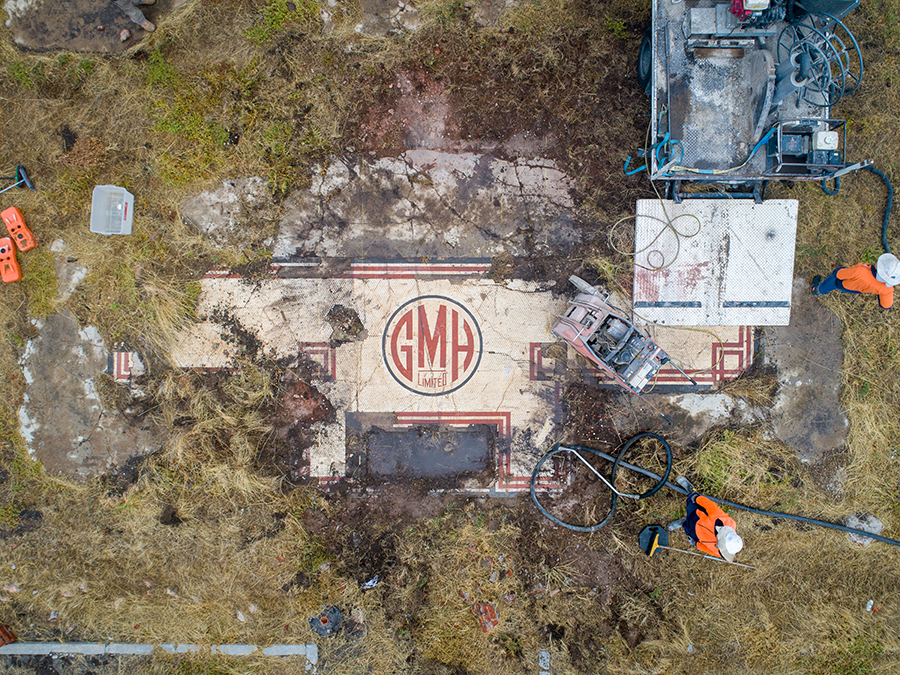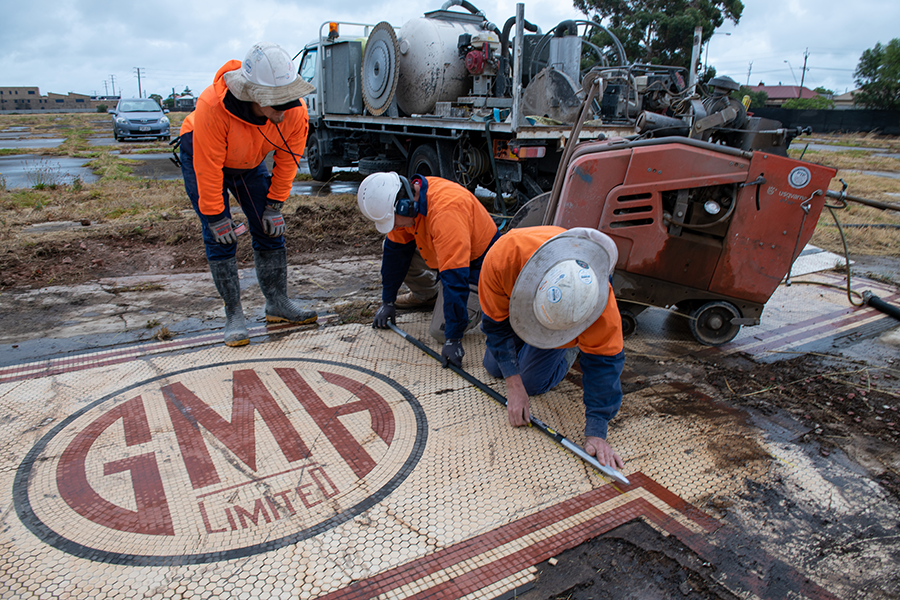Piece of Port history to feature in new harbourside development

A rediscovered piece of South Australia’s automotive heritage has been saved for future generations with the excavation of an art deco mosaic located on the former site of the General Motors Holden (GMH) factory at Port Adelaide.
The mosaic, which is more than 90 years old, used to adorn the floor of the entrance foyer to the long-gone GMH assembly plant.
The plant was once a hive of industrial activity, assembling vehicles from General Motors car bodies manufactured at Woodville from 1926-1965, including Holdens from 1949.
Though the factory came down in 1991, the mosaic has endured. Exposed to the elements, it has—up until now—been largely forgotten by the wider community, masked by weeds on the now vacant 7.7 hectare block at Fletcher’s Slip, near the Birkenhead Bridge.
Now Renewal SA, who owns the site, has partnered with Artlab Australia to retrieve the centrepiece of the mosaic and save it from further environmental damage.
The centrepiece features the GMH Limited logo, a symbolic nod to the alliance between General Motors and Holden when they became one firm in 1931.
The centrepiece will be stored, repaired and later reinstated at the site as a unique feature of the public realm in the new masterplanned residential community that is envisaged there.
“We are delighted that this beautiful vestige of our industrial past has been preserved, as it is something that we have campaigned for and is an important reminder of the role that the GMH factory played in the economic and cultural life of the Port at the time,” said Michelle Hogan, Chair of the Port of Adelaide National Trust.
“Many people don’t even know that the GMH factory existed at Port Adelaide, but now everyone will have the opportunity to learn about it when the mosaic is reinstalled and celebrated as part of future development in the Port.”

The mosaic is the last physical remnant of the GMH factory, which was a saw-tooth building that used to face Nelson Street (formerly Birkenhead Street) and which employed 100 workmen at the time of its launch and had an assembly capacity of 35 cars per day.
When it was opened it was considered to be one of the most modern motor factories in the state, designed by Williams & Sons architects in Adelaide.
The Birkenhead plant was responsible for assembling several different makes of cars—including Chevrolets, Pontiacs, Oldsmobiles, Oaklands, Buicks, Vauxhalls, Cadillacs and G.M.C. trucks—and during the second world war, also turned out a range of army vehicles and marine craft.
During the 1950s, it also assembled about one tenth of the total number of Holdens assembled in Australia. The Holden was known as ‘Australia’s Own Car’ and dominated the Australian car market throughout the 1950s.
The mosaic has now been carefully retrieved following a five-day excavation process managed by Artlab Australia and is being stored in a secure off-site facility until it is ready to be returned to the area as part of the public realm.
Award-winning residential developer Cedar Woods is leading the new development which has commenced at Fletcher’s Slip, which will comprise around 500 new homes as well as a public promenade, parks and plazas.
“Renewal SA is very pleased to be able to honour the heritage of the former GMH factory at this important site for the Port, and wherever possible, endeavours help to blend history with new and exciting urban form so that people can find a meaningful connection to place,” said Damian De Luca, Acting Chief Executive of Renewal SA.
“Once reinstated, the mosaic will be an enduring symbol of the part that Port Adelaide played in Australia’s automotive history and what was the largest car-building organisation in the southern hemisphere.”